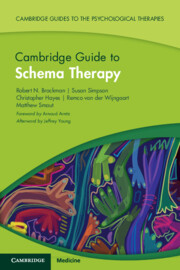62 results
46 Cognitive Reserve and Gait Speed are Associated with Cognitive Performance in Black/African American Older Adults
-
- Journal:
- Journal of the International Neuropsychological Society / Volume 29 / Issue s1 / November 2023
- Published online by Cambridge University Press:
- 21 December 2023, pp. 354-355
-
- Article
-
- You have access
- Export citation
Chapter 14 - Working with Complex Trauma and Dissociation in Schema Therapy
- from Part III - Applications and Adaptations for Mental Health Presentations
-
- Book:
- Cambridge Guide to Schema Therapy
- Published online:
- 27 July 2023
- Print publication:
- 29 June 2023, pp 266-278
-
- Chapter
- Export citation
Chapter 9 - Intervention Strategies for Schema Healing 4
- from Part II - The Model of Schema Therapy in Practice
-
- Book:
- Cambridge Guide to Schema Therapy
- Published online:
- 27 July 2023
- Print publication:
- 29 June 2023, pp 185-211
-
- Chapter
- Export citation
Contents
-
- Book:
- Cambridge Guide to Schema Therapy
- Published online:
- 27 July 2023
- Print publication:
- 29 June 2023, pp vii-viii
-
- Chapter
- Export citation
Chapter 7 - Intervention Strategies for Schema Healing 2
- from Part II - The Model of Schema Therapy in Practice
-
- Book:
- Cambridge Guide to Schema Therapy
- Published online:
- 27 July 2023
- Print publication:
- 29 June 2023, pp 138-149
-
- Chapter
- Export citation
Chapter 10 - Building Connection to Healthy Modes
- from Part II - The Model of Schema Therapy in Practice
-
- Book:
- Cambridge Guide to Schema Therapy
- Published online:
- 27 July 2023
- Print publication:
- 29 June 2023, pp 212-225
-
- Chapter
- Export citation
Chapter 18 - Schema Therapy for the Schema Therapist
- from Part IV - Application of Schema Therapy in Different Populations and in Different Settings
-
- Book:
- Cambridge Guide to Schema Therapy
- Published online:
- 27 July 2023
- Print publication:
- 29 June 2023, pp 314-326
-
- Chapter
- Export citation
Chapter 19 - Supervision and the Supervisory Relationship in Schema Therapy
- from Part IV - Application of Schema Therapy in Different Populations and in Different Settings
-
- Book:
- Cambridge Guide to Schema Therapy
- Published online:
- 27 July 2023
- Print publication:
- 29 June 2023, pp 327-332
-
- Chapter
- Export citation

Cambridge Guide to Schema Therapy
-
- Published online:
- 27 July 2023
- Print publication:
- 29 June 2023
Chapter 4 - Case Conceptualisation and Mode Mapping in Schema Therapy
- from Part II - The Model of Schema Therapy in Practice
-
- Book:
- Cambridge Guide to Schema Therapy
- Published online:
- 27 July 2023
- Print publication:
- 29 June 2023, pp 86-95
-
- Chapter
- Export citation
Part II - The Model of Schema Therapy in Practice
-
- Book:
- Cambridge Guide to Schema Therapy
- Published online:
- 27 July 2023
- Print publication:
- 29 June 2023, pp 39-250
-
- Chapter
- Export citation
Chapter 1 - From Core Emotional Needs to Schemas, Coping Styles, and Schema Modes
- from Part I - Overview of the Schema Therapy Model
-
- Book:
- Cambridge Guide to Schema Therapy
- Published online:
- 27 July 2023
- Print publication:
- 29 June 2023, pp 1-15
-
- Chapter
- Export citation
Chapter 11 - Bypassing Maladaptive Coping Modes to Support Change
- from Part II - The Model of Schema Therapy in Practice
-
- Book:
- Cambridge Guide to Schema Therapy
- Published online:
- 27 July 2023
- Print publication:
- 29 June 2023, pp 226-240
-
- Chapter
- Export citation
Chapter 15 - Schema Therapy for Eating Disorders
- from Part III - Applications and Adaptations for Mental Health Presentations
-
- Book:
- Cambridge Guide to Schema Therapy
- Published online:
- 27 July 2023
- Print publication:
- 29 June 2023, pp 279-288
-
- Chapter
- Export citation
Index
-
- Book:
- Cambridge Guide to Schema Therapy
- Published online:
- 27 July 2023
- Print publication:
- 29 June 2023, pp 356-374
-
- Chapter
- Export citation
Chapter 6 - Intervention Strategies for Schema Healing 1
- from Part II - The Model of Schema Therapy in Practice
-
- Book:
- Cambridge Guide to Schema Therapy
- Published online:
- 27 July 2023
- Print publication:
- 29 June 2023, pp 114-137
-
- Chapter
- Export citation
Chapter 8 - Intervention Strategies for Schema Healing 3
- from Part II - The Model of Schema Therapy in Practice
-
- Book:
- Cambridge Guide to Schema Therapy
- Published online:
- 27 July 2023
- Print publication:
- 29 June 2023, pp 150-184
-
- Chapter
- Export citation
Chapter 13 - Schema Therapy for Chronic Depression and Anxiety Disorders
- from Part III - Applications and Adaptations for Mental Health Presentations
-
- Book:
- Cambridge Guide to Schema Therapy
- Published online:
- 27 July 2023
- Print publication:
- 29 June 2023, pp 251-265
-
- Chapter
- Export citation
Appendix - Interview Questions/Guidance for the Assessment Process (Chapter 3)
-
- Book:
- Cambridge Guide to Schema Therapy
- Published online:
- 27 July 2023
- Print publication:
- 29 June 2023, pp 345-355
-
- Chapter
- Export citation
Chapter 3 - Schema Therapy Assessment
- from Part II - The Model of Schema Therapy in Practice
-
- Book:
- Cambridge Guide to Schema Therapy
- Published online:
- 27 July 2023
- Print publication:
- 29 June 2023, pp 39-85
-
- Chapter
- Export citation

